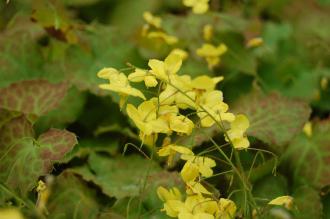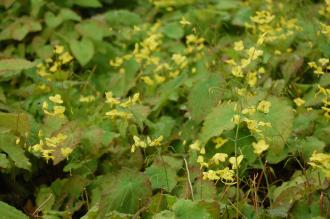
Epimedium perralderianum Flower (05/05/2012, kew garden, London)
Position: Dappled shade to shade
Flowering period: Mid to late spring
Soil: Moist, well drained
Eventual Height: 30cm
Eventual Spread: 60cm
Hardiness: 7a – 10b
Family: Berberidaceae
Epimedium perralderianum is an evergreen low growing, ground covering, herbaceous perennial. Its shiny mid green leaves are divided int three heart shaped leaflets with spiny margins, each up to 10cm long. Its leaves turn bronze in late summer. Its bright yellow flowers are composed of four petals, up to 25mm across, appear on stems which are up to 30cm long above the foliage, each stem containing up to 25 flowers. Its roots are rhizomes which aids its spread.
Epimedium perralderianum, commonly known as Barrenwort or Bishop’s Mitre, is native to north east Algeria. In its natural habitat it grows in Oak or Atlas Cedar forests. It was introduced into the UK in 1862.
The etymological root of the binomial name Epimedium is derived from the Greek name for this plant, used by Dioscorides and Pliny. Perralderianum is named after a French naturalist Henri Rene le Tourneaux de la Perraudiere.

Epimedium perralderianum (05/05/2012, kew garden, London)
The landscape architect may find Epimedium perralderianum useful as an evergreen, low growing, ground cover in shady locations. This plant is rabbit resistant.
Ecologically, E. perralderianum is attractive to pollinating insects.
E. perralderianum prefers moist, humus rich, well-drained soils. It prefers an acid to neutral pH of soil, although it will tolerate most soils.
Epimedium perralderianum requires little maintenance. Large clumps may be divided in autumn.

